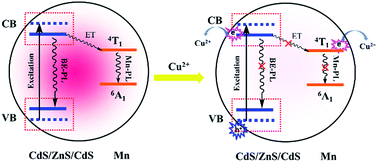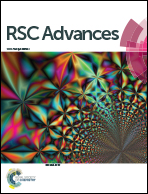Mn-doped CdS/ZnS/CdS QD-based fluorescent nanosensor for rapid, selective, and ultrasensitive detection of copper(ii) ion
Abstract
A facile strategy for designing a glutathione-capped Mn-doped CdS/ZnS/CdS core/shell/shell QD-based fluorescent nanosensor has been developed for rapid, selective, and ultrasensitive detection of Cu2+. In this nanosensor, glutathione provided the binding and recognition sites for Cu2+, accumulating Cu2+ on the QD surface. The energy transfer pathway from the host to the Mn dopant was sensitive to the interferences from non-radiative recombination pathways caused by Cu2+, resulting in photoluminescence quenching. The nanosensor responded to Cu2+ within one minute and exhibited good selectivity to Cu2+ over other metal ions and good linear correlation over the concentration range of 1 nM to 100 nM, with a detection limit as low as 0.74 nM. Moreover, this nanosensor avoids the self-quenching problem and autofluorescence in biosystems due to the substantial Stokes shift and long lifetime, and thus can be used to monitor Cu2+ in living cells.


 Please wait while we load your content...
Please wait while we load your content...